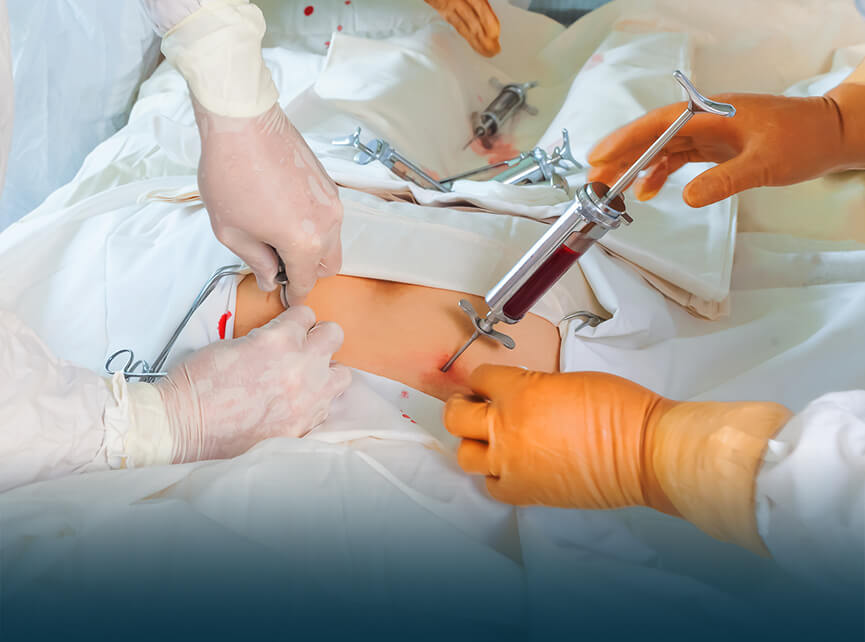About Treatment
Bone Marrow Transplantation is the infusion of healthy hematopoietic somatic cells into patient's body to replace damaged and suffering bone marrow. Bone marrow transplantation is also called somatic cell transplantation.
Bone marrow transplantation may be required if the bone marrow has stopped working and does not produce enough healthy blood cells.
In bone marrow transplantation, it is possible to use cells from patient's own body (autologous transplantation) or from a donor (allogeneic transplantation).
Types of BMT
Allogeneic Transplantation
Autologous Transplantation
When BMT is needed
BMT can be indicated in the following situations:
A safe way to treat patient's condition with high-dose chemotherapy or radiation therapy to replace or save bone marrow damaged during treatment
Replace diseased or damaged bone marrow with new somatic cells
Providing new somatic cells that can help destroy cancer cells directly
Bone marrow transplantation can save patients with many pathologies, both malignant and benign nature of the disease, for example:
Acute Leukemia
Adrenoleukodystrophy
Aplastic Anemia
Bone Marrow Failure Syndrome
Chronic Leukemia
Hemoglobinopathies
Hodgkin's Lymphoma
Immunodeficiencies
Inborn Errors of Metabolism
Multiple Myeloma
Myelodysplastic Syndromes
Neuroblastoma
Non-Hodgkin's Lymphoma
Plasma Cell Disorders
POEMS Syndrome
Primary Amyloidosis
BMT Preparation
Transplant tests and procedures
Patient will need to go through a series of tests and studies to diagnose general body condition and status in order to make sure that body is ready for BMT. The examination may take several days or even more.
In addition, the doctor will install a long thin tube (central venous intravenous catheter) into a large vein in the upper chest or neck. The catheter usually remains in place throughout the treatment period. BMT team will use it to inject somatic cells previously collected for BMT, as well as various medications and blood products into patient's body.
Transplantation Somatic Cell Collection
If BMT is planned using patient's own somatic cells (autologous transplantation), patient will undergo a procedure called apheresis to collect blood somatic cells.
Before apheresis, patient will receive daily injections of growth factor to increase somatic cell production and increase somatic cells in circulating blood so that they can be collected.
The apheresis device divides blood into different parts, including somatic cells. Somatic cells are collected and frozen for future use in transplantation. The remaining blood returns to the body.
If you plan to transplant using a donor somatic cell (allogeneic transplant), you will need a donor. When you have a donor, somatic cell is taken from that person for subsequent transplantation. This process is often referred to as somatic cell or bone marrow collection. Somatic cells can be used derived from the blood of donor or bone marrow. Transplant team decides which is best for you depending on your situation. Transplant team will best determine what type of transplant is right for you in your particular situation.
Another type of allogeneic transplantation uses somatic cells from umbilical cord blood (cord blood transplant). Mothers can choose to donate umbilical cord blood from the umbilical cord after giving birth. Blood from the umbilical cord is frozen and stored in a cord blood bank until it is needed for bone marrow transplantation.
What to expect during BMT
On the day of transplant, called day zero, somatic cells are introduced into your body through the catheter. Infusion, the introduction of intravenous donor cells is painless. During the procedure, patient is awake.
Transplanted somatic cells enter the bone marrow, where they begin to create new blood cells. The production of new blood cells can take several weeks, after which, accordingly, blood counts can begin to recover.
Bone marrow or blood somatic cells that have been frozen and thawed contain preservative that protects the cells. Shortly before transplantation, patient may be prescribed medications to reduce side effects that may be caused by preservative. Patient will also probably be given intravenous fluids (hydration) before and after transplantation to help the body to get rid of the preservative.
-
Diagnosis before BMT
HLA
MRI
PET CT
Blood Tests
Bone Marrow Biposy
-
Side Effects
Nausea and vomiting
Mouth Sores
Fatigue
Low levels of platelets
Low levels of red blood cells
Diarrhea
Bone marrow transplantation has many complications, some of which are potentially fatal.
The risk may depend on many factors, including the type of disease or condition, type of transplant, age and health of the person receiving the transplant.
Although some people experience minimal bone marrow transplant problems, in others the process can occur with complications that may require treatment or hospitalization. Some complications can even be life threatening.
Complications that may occur during bone marrow transplantation include:
Graft versus Host - GVHD reaction (allogeneic transplantation only)
Somatic Cell Deficiency (Transplant)
Organ damage
Infections
Cataract
Infertility
New types of cancer
Death
When new somatic cells enter the body, they begin to spread throughout the body, including the bone marrow. Over time, they increase in number and begin to create new healthy blood cells. This is called engraftment. It usually takes several weeks before the number of blood cells in your body begins to normalize. For some people, this may take longer.
On the days and weeks after bone marrow transplantation, blood test is taken and other tests performed to monitor condition.
After bone marrow transplantation, patient is under direct medical monitoring. If you there are infectious or other complications, patient may need to stay in hospital for several days or sometimes longer. Depending on the type of transplant and the risk of complications, patient needs to stay close to the hospital for several weeks or months in order to carry out careful monitoring.
Patient may also need to periodically transfuse red blood cells and platelets until the bone marrow begins to produce enough of these cells on its own. Patient may be at greater risk of infection or other complications for several months to several years after transplantation.
BMT can lead to a cure for some diseases, some diseases pass through remission due to BMT. Bone marrow transplant goals depend on individual situation, but usually include controlling or treating the disease, prolonging life, and improving quality of life.
Some people undergo bone marrow transplantation with minor side effects and complications. Others experience many complex problems, both short-term and long-term. The severity of side effects and the success of transplantation vary from person to person, and sometimes it can be difficult to predict the moment before transplantation.
This can be discouraging if serious problems arise during the transplantation process. However, it is sometimes useful to remember that there are many survivors who also experienced very difficult days during the transplantation process, but ultimately successfully completed the transplantation and returned to normal activities with a good quality of life.











